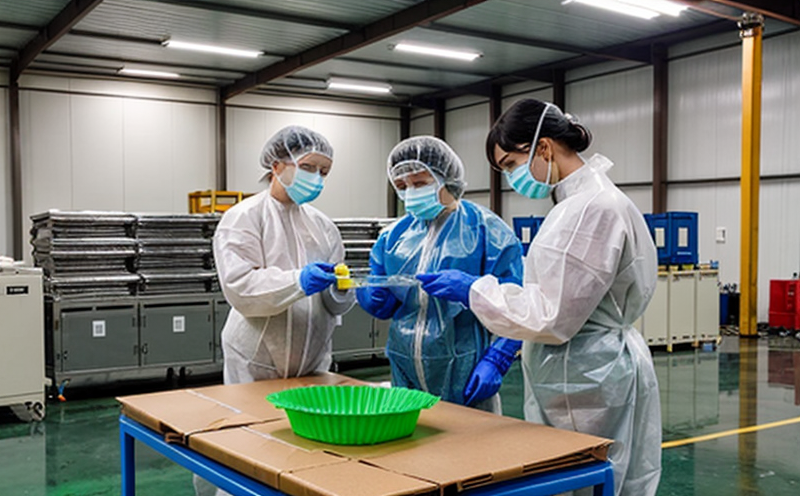ISO 1133-5 MFR Testing under Load
The ISO 1133-5 test method is widely recognized as a standard procedure for measuring the melt flow rate (MFR) of thermoplastics, particularly under conditions that simulate real-world processing. This testing methodology is crucial in quality assurance and R&D processes where precise control over polymer properties is necessary.
The MFR measurement provides insight into the molecular weight distribution and processing behavior of polymers during extrusion or injection molding operations. Testing under load helps engineers understand how a material will perform when subjected to mechanical stress, which is particularly important for plastic packaging that must withstand various forms of handling before reaching consumers.
The ISO 1133-5 test apparatus consists of a heating block and a piston/cylinder system where the sample is extruded under specified load. The weight required to maintain a constant extrusion rate over time determines the MFR value, which can be expressed in grams per 10 minutes (g/10min).
For plastic packaging testing specifically, ISO 1133-5 allows for the assessment of how packaging materials will behave under dynamic loading conditions. This is vital when designing lightweight and robust packaging that must balance cost-effectiveness with durability. Understanding MFR under load helps in optimizing formulations to ensure performance during extrusion or blow molding processes.
The testing procedure involves precise control over temperature, pressure, and extrusion rate, all of which can influence the outcome. Proper specimen preparation is critical; this includes ensuring uniformity and homogeneity within the sample, as well as accurate measurement of the sample weight before testing.
Understanding the MFR under load values allows packaging engineers to make informed decisions about material selection and processing parameters. For instance, higher MFR values indicate a lower molecular weight distribution, which can result in easier processing but potentially less robust performance. Conversely, lower MFRs suggest more complex polymers that are harder to process but offer greater strength.
The test results provide valuable data for quality assurance teams and R&D departments, enabling them to monitor production processes and improve product design. By adhering to ISO 1133-5 standards, manufacturers can ensure consistent performance across batches, thereby enhancing the reliability of plastic packaging products in various sectors.
- Identifies optimal processing conditions for thermoplastic materials
- Predicts long-term performance under stress conditions
- Ensures compliance with international quality standards
- Supports continuous improvement of manufacturing processes
Applied Standards
The ISO 1133-5 standard is applicable to a wide range of thermoplastics, including polyethylene (PE), polypropylene (PP), and polystyrene (PS). These materials are commonly used in plastic packaging due to their versatility and cost-effectiveness. The test method provides specific guidelines for specimen preparation, heating conditions, and extrusion rates that must be strictly adhered to ensure accurate results.The standard specifies the use of a precise MFR tester equipped with a heated cylinder, piston, and scale. The sample is placed in the cylinder, which is then heated to the specified temperature while applying a constant load. The extrusion rate of the material is measured over time using a stopwatch, and this data is used to calculate the MFR value.
For plastic packaging testing under ISO 1133-5, it's important to note that the standard also includes considerations for sample conditioning, such as temperature and humidity control. This ensures that the material properties are consistent with those expected in real-world applications. The test results help manufacturers to understand how their materials will behave during extrusion or blow molding processes, which is crucial for producing high-quality packaging products.
Scope and Methodology
ISO 1133-5 MFR testing under load provides a comprehensive framework for evaluating the processing characteristics of thermoplastics. The method involves subjecting the material to a controlled temperature environment while applying an external force, simulating real-world extrusion or blow molding conditions.The scope of this test extends beyond simple melt flow rate measurement; it also evaluates how materials behave under stress, which is particularly important for plastic packaging that must withstand various forms of handling. The methodology ensures that the results are consistent and reproducible, allowing for accurate comparison between different samples or batches.
The testing process begins with specimen preparation, where uniformity and homogeneity are crucial. This involves cutting the sample to a specified size and ensuring it is free from defects. Once prepared, the sample is placed in the MFR tester's cylinder, which is then heated to the appropriate temperature while applying the required load.
The extrusion rate of the material is monitored over time using a stopwatch, and this data is used to calculate the melt flow rate value. The standard specifies precise conditions for each step, including heating rates, residence times, and cooling methods, to ensure accurate results. By adhering to these guidelines, manufacturers can produce packaging materials that meet strict quality standards.





